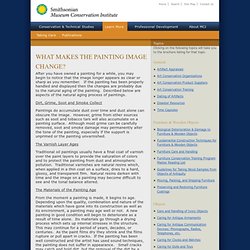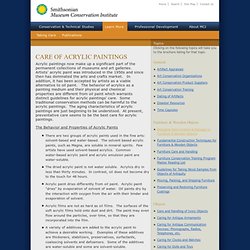

Museum Conservation Institute What Makes the Painting Image Change? After you have owned a painting for a while, you may begin to notice that the image longer appears as clear or sharp as you remember.

If the painting has been properly handled and displayed then the changes are probably due to the natural aging of the painting. Described below are aspects of the natural aging process of paintings. Dirt, Grime, Soot and Smoke Collect Paintings do accumulate dust over time and dust alone can obscure the image. However, grime from other sources such as soot and tobacco tars will also accumulate on a painting surface. The Varnish Layer Ages Traditional oil paintings usually have a final coat of varnish over the paint layers to provide the saturation of colors and to protect the painting from dust and atmospheric pollution. The Materials of the Painting Age From the moment a painting is made, it begins to age. If the paint film is thick and contains too much oil, the surface may wrinkle. Some Pigments Change Physical Damage Happens What To Do? Pigments and their Chemical and Artistic Properties.
Museum Conservation Institute Painting Varnishes. What does a Varnish do for a Painting?

The varnish layer plays a dual role: it has and effect on the final appearance of the painting and also serves as a protective coating for the paint surface. Varnishes intensify the appearance of pigments on the painting surface by the refraction of light. This is called "saturation. " Although varnishes are traditionally clear, they can be toned or altered with the addition of pigments and other materials. Toned varnishes may be utilized to balance a painting whose appearance has changed with age.
What is a Painting Varnish? Varnishes are solutions of natural or synthetic resins in organic solvents that dry when spread thinly on a surface. The variety of varnishing materials is as diverse as the choices of paint media and techniques throughout the history of painting. Many of these natural materials are still in use today by artists and restorers. Does the Varnish Layer Ever Change? Museum Conservation Institute Does My Painting Need to be Cleaned? Why Might My Painting Need to be Cleaned?

Taking care of your paintings is delicate and complex. As paintings age, the appearance of the image changes not only because of accumulated dirt, but also because aging itself can alter the materials that make up the image. Methods of removing dirt and other obscuring material requires great skill because any changes to the painting surface may bring about irreversible and damaging results, permanently affecting the aesthetic and monetary value of the work.
What Is Cleaning? Discolored varnish can be removed during the cleaning of the painting surface. Museum Conservation Institute Care of Acrylic Paintings. Acrylic paintings now make up a significant part of the permanent collections of museums and art galleries.

Artists' acrylic paint was introduced in the 1950s and since then has dominated the arts and crafts market. In addition, it has been accepted by artists as a viable alternative to oil paint. The behavior of acrylics as a painting medium and their physical and chemical properties are different from oil paint which warrants distinct guidelines for acrylic paintings' care. Some traditional conservation methods can be harmful to the acrylic paintings. Museum Conservation Institute Caring for Your Paintings. What is a Painting?

A traditional painting is constructed, in order from bottom to top, of the support, ground, paint, and coating. The majority of paintings are on either fabric or a wooden panel. Fabric supports are stretched over stretchers with keys (flat triangular wedges, traditionally wooden) in the corners to adjust the tension of the fabric and to prevent bulges and creases. The ground provides a smooth surface for the paint and serves as a "sponge" to absorb excess binding media of the paint. The paint on top of the ground can be a very thin single layer or multiple layers. Handling Paintings Great care needs to be taken when handling paintings. Improper framing and loose keys should be corrected before handling. How to Hang Paintings Appropriate sized, sturdy hardware should be used when hanging any painting. Paintings may be suspended on a metal hook secured to the frame or from the appropriate weight painting (or picture) wire.
What to do about Displaying Paintings Dusting. Museum Conservation Institute Painting Conservation Glossary of Terms.